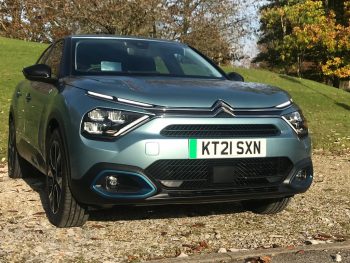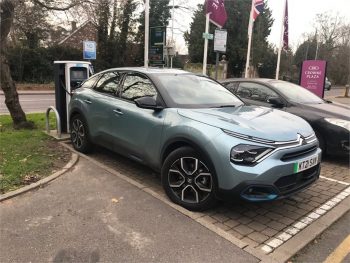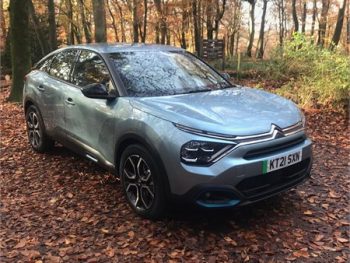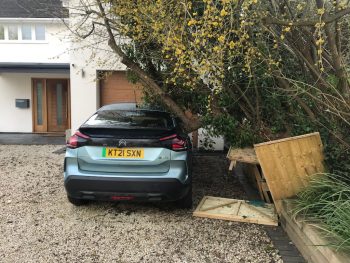Fleet World Fleet: Citröen ë-C4
Nat Barnes calculates the charging costs for the ë-C4 and looks at why smart charging is so important.

On a smart charger and on an EV tariff, you’ll pay 7.5p/kWh with Octopus, which equates to £3.75 for a full 50kW in the ë-C4
Citröen ë-C4 Sense Plus:
P11d (BiK): £32,125 (2%) Range: 217 miles Efficiency: 4.03mpkWh Test efficiency: 4.1mpkWh
Report 4
In my previous report on the Fleet World Citröen ë-C4, I mentioned the uplift in economy that I’d seen with the spring temperatures improving. That’s continuing too with me regularly returning over 4.0mpkWh without even trying. As it’s warmer, I’ve even been starting to use the air conditioning on occasion and, rather strangely, that seems to have had no effect on the Citröen’s efficiency.
But what does that efficiency mean both for drivers and, crucially, those running larger fleets? It’s a question that fleet managers are going to have to ask themselves more and more in the future, particularly when it comes to running costs. It’s not just about the efficiency of the cars either, it’s about the differences in charging costs too, especially when many on-road chargers have started raising the prices.
So, let’s take my ë-C4 as an example and imagine I could charge its 50kW battery from zero to 100%. To keep things simple, I’m also not going to muddy the waters with connection or standing charges at home or on the road. So at home, on a smart charger and on an EV tariff, you’ll pay 7.5p/kWh, with Octopus which equates to £3.75 for that full 50kW.
Obviously at present, domestic electricity prices are rising quickly. At the time of writing, the UK average is 28p/kWh, where that same 50kW charge will cost you a heftier £14. That’s a big jump, but that £14 in a petrol station will barely get you two gallons of fuel, so it’s still cheaper than petrol or diesel. It’s also why smart chargers that can report directly back to fleet managers to reimburse staff automatically will be so helpful in the long term.
But what about on the road? Again, this is where smart fleet managers will set their drivers up with staff accounts (or encourage them to set up accounts of their own to reclaim) due to the savings. Use a BP Pulse 50kW charger using contactless and it will be 56p/kWh, but with a subscription that drops to 43p/kWh. With our 50kW charge for our ë-C4, that’s the difference between £28 and £21.50, so that seemingly small 13p difference can soon add up – especially if you’ve got a fleet of, say, 100 EVs or more.
And that’s for BP Pulse, Ionity put up its prices in April 2022, so that just driving up and paying via contactless without an Ionity account will set you back 72p/kWh. That works out to… are you sitting down… a hefty £36 for that 50kW charge – that’s almost TEN TIMES what it costs to charge at home. And if that fact alone doesn’t have fleet managers everywhere sitting up and paying attention about the costs of EV charging, then I don’t know what will.

Peace-of-mind top-ups for the ë-C4 have been rendered redundant with the warmer weather
Report 3
The warmer weather has meant many things. The shorts have been dusted off and are out of the wardrobe, the cover is off the barbecue and there’s the annual discussion of whether sun cream can really have a best-before date.
And there’s the fuel efficiency of my Citröen ë-C4. In all honesty, in all the years of driving ICE cars, beyond using the air conditioning, I can honestly say that I very rarely gave a second thought to the weather’s effect on a car’s fuel economy. Since spring arrived and the temperature started rising, however, it’s almost all I can think about with the ë-C4. I know, I know, I’m thrilling company at dinner parties, honest…
The reason is that having driven the ë-C4 through chillier winter temperatures, its fuel efficiency rarely deviated from 3.4mpkWh. And yet now I’m regularly achieving 4.1 without even trying.
It may not sound like much, but a regular journey from my home in Marlow in Bucks to West Sussex demonstrates that it actually is. Driving on the M40 and M25 for a large part of that journey has always meant that it’s not great for efficiency. While the ë-C4 could probably (just about) make it there and back without charging in the winter, I always chose to stop for a quick 15-minute top-up at a local 50kW charger for peace of mind.
Now though, with that step up in efficiency, not only do I not have to charge en route, but I’m even returning home with around 40 miles of range left – something that never would have been possible before.
I’ll drill down into more detail about running costs in my next report, but it’s a timely reminder that anyone running a business fleet will need to expect plenty of fluctuation depending on the weather and look at the overall running costs of any EVs throughout the course of a full calendar year, not just during those warmer months.

More than a quarter of all C4s leaving showrooms are now the ë-C4 as opposed to the petrol and diesel C4 versions
Report 2
In keeping with the time theme of my previous report about the clocks going back, the ë-C4 has got me thinking about time.
The reason is that most recently I drove its Stellantis cousin, the Vauxhall Astra plug-in hybrid, and before that I also drove the Peugeot 308 with the same PHEV set-up last summer. Both are very competent cars and dynamically can probably put the ë-C4 in the shade in terms of sheer driving pleasure.
But for all their advantages, neither car will offer a fully electric version like the ë-C4 until 2023, while my fully electric Citröen has now been on sale since early 2021. So, the crucial question is: is it better to be first like the Citröen or better like the Astra and 308 (which will be, by 2023, newer and have a bigger battery and longer range)?
Citröen has improved the range of the e-C4 with a heat pump, but in the meantime it has enjoyed a full two-year sales head start on its in-house rivals – and it’s showing too. More than a quarter of all C4s leaving showrooms are now the ë-C4 as opposed to the petrol and diesel C4 versions, which is no small figure – especially when you remember that every manufacturer has crucial CO2 targets to meet.
Plus, for those after an electric hatchback, there’s not an awful lot of choice on the market unless you want to go for a crossover, so the chances are that quite a few of those ë-C4 customers are probably new to Citröen too.
Yes, there’s a lot less brand loyalty these days, particularly with electric cars, but that’s a hefty competitive advantage in my view – and one that the ë-C4 fully deserves.

Storm Eunice took its toll on our long termer
Report 1
Spring has arrived and so has my new Citröen ë-C4 long-termer. It’s no surprise that Fleet World is adding another EV to the fleet. Research by insurance firm Willis Towers Watson showed that just over a third of UK companies now give their staff the option to drive an electric or hybrid vehicle.
While that may not sound like a high number, it’s actually double the same figure for 2020 and there’s little doubt that business drivers are pushing that EV demand. In fact, the BVRLA estimates that by 2025, the vehicle rental, leasing and fleet industry will be responsible for 80% of sales in the UK.
Never mind the rises though, it’s more the falls I’m worried about. The ë-C4 unfortunately bore the brunt of Storm Eunice as our neighbour’s tree fell on it putting a dent in the rear wing and roof while on our driveway. In fact, it could have been so much worse.
Normally I back up to our house for charging purposes, but a full charge and laziness on my part after a short journey, meant by sheer fluke I’d parked facing forwards instead. If it had been the other way, the tree would have hit the bonnet and gone through the windscreen.
As it was, the rear wing bore the not-inconsiderable weight of the tree and held it up, preventing it from falling any further. It was only when removing the tree and discovering just how heavy it was, that the strength of the Citröen’s bodywork really came to light. Not something I’d recommend you check yourself…
Citröen kindly swapped us into a regular petrol C4 for a few days while KT21SXN went in for repairs which just underlined how much we’d altered our driving habits to suit electric power. Quite aside from the reminder of changing gear with a manual gearbox, the loss of any regenerative braking when going downhill was certainly an eye-opener at first. And, as much as I’m not the biggest fan of technology, even I had to admit that I’d especially missed the ë-C4’s keyless go compared to the C4’s traditional ignition key and lock.
In the meantime though, we’re looking forward to some spring motoring miles back under electric power.












